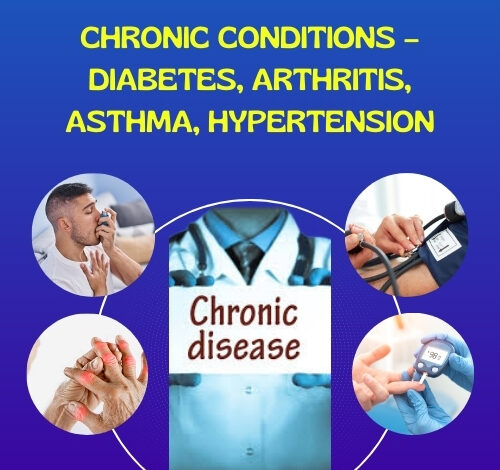Chronic Conditions – Diabetes, Arthritis, Asthma, Hypertension

In today’s fast-paced world, chronic conditions have become increasingly prevalent, impacting millions globally. These long-term illnesses can significantly affect an individual’s quality of life and place a heavy burden on healthcare systems. Among the most common chronic conditions are diabetes, arthritis, asthma, and hypertension. Understanding these conditions, their causes, symptoms, and management strategies is essential for effective long-term care. Each of these chronic illnesses, exploring how they affect the body, the latest treatment approaches, and the role of natural remedies such as Joint Support Herbal Supplement for Arthritis.
Understanding Chronic Conditions
Chronic conditions are diseases or health disorders that persist for a year or more and require ongoing medical attention or limit activities of daily living—or both. These conditions often develop slowly and can be managed but not always cured. They include both physical illnesses like cardiovascular disease and diabetes, as well as respiratory conditions such as asthma and musculoskeletal issues like arthritis.

According to the World Health Organization, chronic conditions are the leading cause of death and disability worldwide. They are influenced by genetic, environmental, and lifestyle factors, including poor diet, lack of exercise, and exposure to pollutants.
Let’s explore the four major chronic conditions that affect millions globally: diabetes, arthritis, asthma, and hypertension.
Diabetes: The Silent Invader
What is Diabetes?
Diabetes is a chronic metabolic disorder characterized by high blood glucose levels. It occurs either when the pancreas does not produce enough insulin (Type 1 diabetes) or when the body cannot effectively use the insulin it produces (Type 2 diabetes). A third type, gestational diabetes, affects pregnant women and usually resolves after childbirth.

Causes and Risk Factors
- Genetic predisposition
- Obesity and physical inactivity
- Poor diet
- Aging
- High blood pressure and cholesterol
Symptoms of Diabetes
- Frequent urination
- Excessive thirst
- Extreme hunger
- Fatigue
- Blurred vision
- Slow-healing wounds
Management and Treatment
Managing diabetes involves a combination of medication, diet, and exercise. Insulin therapy is essential for Type 1 diabetes, while oral medications and lifestyle changes can manage Type 2. Monitoring blood sugar levels and maintaining a healthy weight are crucial.
Arthritis: The Painful Inflammation
What is Arthritis?
Arthritis refers to the inflammation of joints, causing pain and stiffness. It includes over 100 different types, with osteoarthritis and rheumatoid arthritis being the most common. Osteoarthritis results from wear and tear of cartilage, while rheumatoid arthritis is an autoimmune condition where the immune system attacks joint tissues.

Causes and Risk Factors
- Age
- Gender (more common in women)
- Family history
- Obesity
- Previous joint injuries
Symptoms of Arthritis
- Joint pain and stiffness
- Swelling and redness
- Decreased range of motion
- Fatigue
Management and Treatment
Treatment focuses on relieving symptoms and improving joint function. Options include:
- Anti-inflammatory medications
- Physical therapy
- Joint replacement surgery (in severe cases)
- Lifestyle changes like weight loss and exercise
- Natural remedies such as Joint Support Herbal Supplement for Arthritis, which may offer pain relief and improve joint flexibility.
Herbal supplements often combine ingredients like turmeric, boswellia, and ginger, known for their anti-inflammatory properties. These supplements provide a natural approach to arthritis management and can be used alongside conventional treatments.
Asthma: Breathing with Difficulty
What is Asthma?
Asthma is a chronic respiratory condition characterized by inflammation and narrowing of the airways, making breathing difficult. It can be triggered by allergens, exercise, cold air, or respiratory infections.

Causes and Risk Factors
- Genetic predisposition
- Environmental allergens
- Respiratory infections in childhood
- Air pollution
- Smoking
Symptoms of Asthma
- Shortness of breath
- Wheezing
- Chest tightness
- Coughing, especially at night or early morning
Management and Treatment
Asthma has no cure, but it can be managed with medications and lifestyle adjustments:
- Inhalers (bronchodilators and corticosteroids)
- Allergy medications
- Avoiding triggers
- Breathing exercises
Developing an asthma action plan with a healthcare provider can help individuals manage flare-ups and maintain control over their condition.
Hypertension: The Silent Killer
What is Hypertension?
Hypertension, or high blood pressure, is a chronic condition where the force of the blood against artery walls is consistently too high. If left uncontrolled, it can lead to heart disease, stroke, and kidney failure.

Causes and Risk Factors
- Obesity
- High salt intake
- Lack of physical activity
- Smoking and alcohol consumption
- Stress
- Family history
Symptoms of Hypertension
Hypertension is often called the “silent killer” because it usually has no symptoms until significant damage has occurred. Some individuals may experience:
- Headaches
- Nosebleeds
- Shortness of breath
- Dizziness
Management and Treatment
Lifestyle changes and medication can effectively manage hypertension:
- Eating a balanced diet (DASH diet)
- Regular physical activity
- Reducing salt intake
- Stress management techniques
- Antihypertensive drugs
Monitoring blood pressure regularly and adhering to prescribed treatment can prevent complications.
Integrated Approach to Managing Chronic Conditions
Managing chronic conditions often requires a holistic and integrated approach. While medication is crucial, combining it with lifestyle changes, mental health support, and alternative therapies can improve outcomes. Here are some strategies:
1. Diet and Nutrition
Eating a balanced, nutrient-rich diet supports overall health and helps manage weight, blood sugar, and inflammation. Diets rich in fruits, vegetables, lean protein, and whole grains are beneficial.
2. Regular Physical Activity
Exercise improves cardiovascular health, strengthens muscles, reduces stress, and helps in weight management. It is crucial for people with diabetes, arthritis, and hypertension.
3. Stress Management
Chronic stress can worsen many health conditions. Techniques such as yoga, meditation, and deep breathing exercises are effective in reducing stress and improving mental well-being.
4. Natural Supplements
Supplements like the Joint Relief Supplement for Joint Health and Joint Mobility offer a complementary approach to conventional treatments. Natural anti-inflammatories and antioxidants can reduce symptoms and promote healing.
5. Regular Monitoring and Medical Check-ups
Early detection and ongoing monitoring are key to managing chronic conditions. Regular check-ups with healthcare professionals can help in adjusting treatment plans and preventing complications.
The Economic and Social Impact of Chronic Conditions
Chronic conditions not only impact individual health but also pose a significant burden on healthcare systems and economies. The cost of treatment, loss of productivity, and long-term care needs are substantial. Employers, governments, and communities must work together to create supportive environments that promote healthy living and disease prevention.
Chronic illnesses can also affect mental health, leading to anxiety, depression, and social isolation. It is crucial to integrate psychological support into treatment plans.
Conclusion
Chronic conditions such as diabetes, arthritis, asthma, and hypertension are major public health challenges. With proper management, individuals can lead fulfilling lives despite their diagnoses. A multifaceted approach—including medical treatment, lifestyle changes, mental health care, and the use of natural remedies like Joint Support Herbal Supplement for Arthritis—can make a significant difference.
Awareness, education, and proactive care are key to controlling these conditions. As the global population ages and lifestyles change, understanding and addressing chronic conditions will remain a top priority for individuals, communities, and health systems alike.





